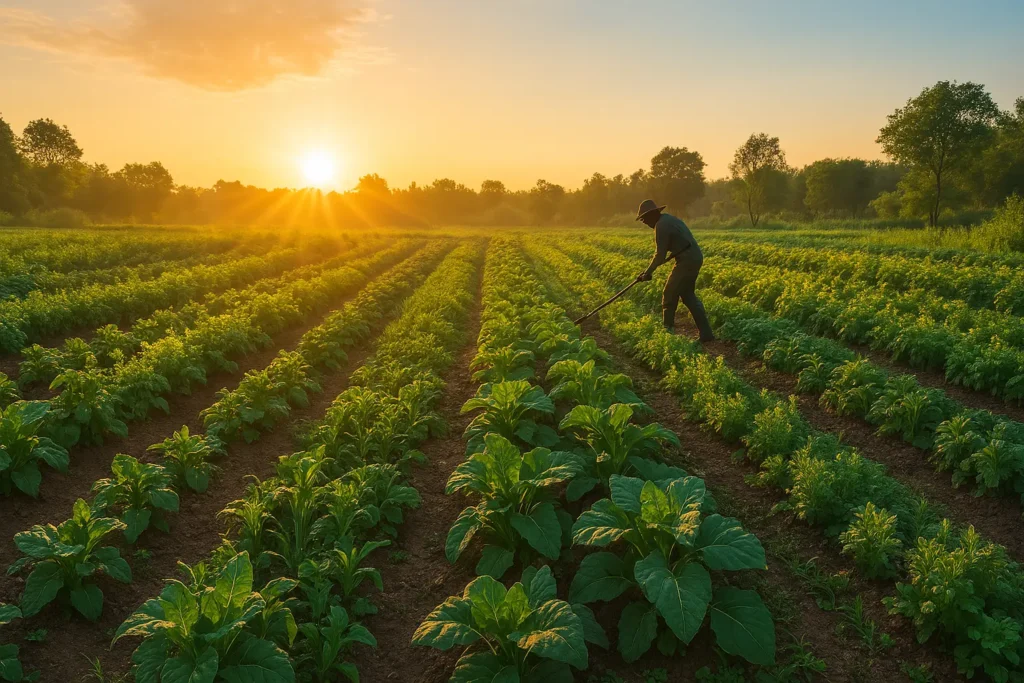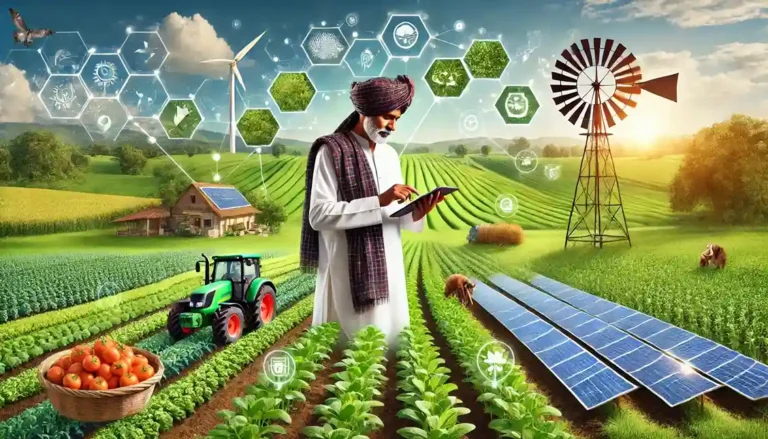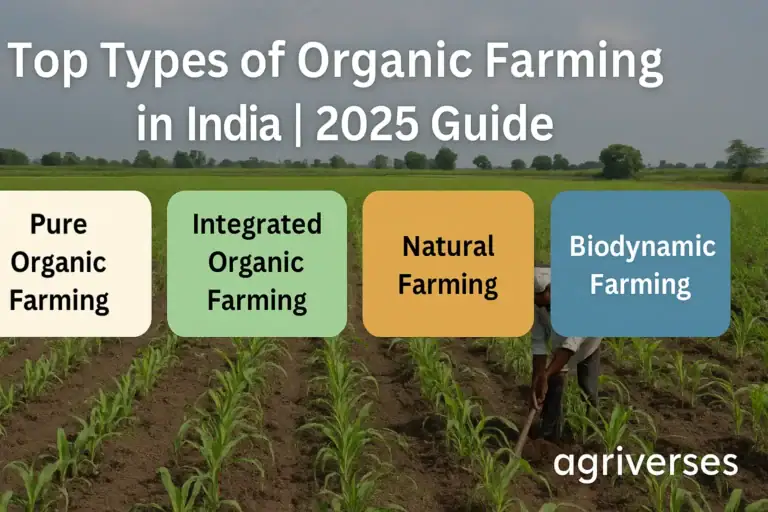Introduction

Hello friends, do you know regenerative agriculture is a better farming technique than organic farming and sustainable farming, which is very beneficial for our environment. But people do not know or have not heard as much about this technique as they have about organic farming and sustainable farming. So today we will discuss about that farming, its definition, its technique and how this farming is better for our environment than organic and sustainable agriculture.
Do you know that in India 30% land and 7 million hectares of land is becoming barren due to soil degradation. Excessive use of chemicals, more irrigation than necessary, and monocropping (growing a single crop in the same field repeatedly) have destroyed the fertility of the soil.
Because of which our yield decreased, and our farming expenses also increased, due to which food security also started to be a concern. Regenerative farming is not a buzzword – it is an outstanding mixture of ancient knowledge and modern knowledge which can prove to be a savior for the distressed farmers of India whose land has become barren.
“Falling yields and rising input costs are pushing farmers into debt cycles,” warns Dr. Rakesh Chaturvedi, soil scientist at ICAR.
Comparison Table
| Aspect | Organic Farming | Sustainable Ag. | Regenerative Ag. |
|---|---|---|---|
| Goal | Avoid chemicals | Balance resources | Heal ecosystems |
| Soil Health | Maintains | Preserves | Restores & enriches |
| Biodiversity | Low focus | Moderate | High priority |
| Carbon Sequestration | Minimal | Some | Major focus |
| Certification Needed? | Yes (e.g., NPOP) | No | No (outcome-based) |
Organic Farming Comparison
Regenerative farming is different from organic farming. Organic farming avoids synthetic stuff. But regenerative farming focuses on fixing ecosystems and soil health. It uses biodiversity and less tillage.
This is key: organic farming skips chemicals, but regenerative farming regenerates the land’s natural ways.
What is Regenerative Agriculture
Regenerative agriculture is more than farming. It is a way to fix ecosystems and grow food. As an agricultural student, I’ve seen it fix soil damage. Let’s look at how it is different from old ways and why it is important for India’s farms.
India’s farming success depends on healthy soil. But years of hard farming have taken away nutrients. This has left fields weak. Regenerative agriculture offers a science-backed way to fix this.
Unlike conventional farming, which depletes the land, regenerative agriculture restores it. It’s a holistic approach centered on:
- This method uses techniques like crop rotation and composting. It directly meets India’s need for sustainable farming. It’s a way to make farming better for the future.
- Soil damage affects over 50% of India’s land. Regenerative methods like cover crops and less tilling help. These methods make soil fertile again naturally.
- They also improve water use and biodiversity. This makes crops stronger. For Indian farming, this change could bring balance and stability.
Core Principles of Regenerative Farming
- Minimal Soil Disturbance: Reducing tillage preserves soil structure which cuts down erosion and keeps microbes alive.
- Cover Cropping (soil armor): Planting crops like legumes or clover between harvests prevents erosion and enriches the soil and also protect the soil from sun and harmful winds.
- Diverse Crop Rotations and maintain biodiversity in crops: Rotating different crops disrupts pest cycles naturally, reducing the need for pesticides.
- Composting & Organic Matter: Utilizing compost and organic fertilizers revitalizes soil life.
- Agroforestry & Livestock Integration: Combining trees, crops, and animals creates a self-sustaining ecosystem.
The Science Behind Soil Regeneration
Soil science shows regenerative farming boosts carbon capture. When soil is not disturbed, microbes work better, speeding up nutrient cycles. Cover crops add organic matter, making soil better over time.
This is not just theory. It works in farms in Maharashtra and Odisha, where yields went up 30% without chemicals.
Traditional Indian Farming Practices That Align with Regenerative Agriculture
Traditional Indian farming views soil as a living thing. It uses methods like crop rotation and green manuring. These were key long before today’s regenerative ideas came along.
Jeevamrut is a soil enhancer made from cow products and natural stuff. It shows the start of zero budget farming. In North India, Navdanya and in South India, tank irrigation systems are great for water and biodiversity.
Key Techniques of Regenerative Agriculture: Restoring India’s Soil Health

Regenerative agriculture is changing farming in India. It tackles soil problems with no-till farming India and cover cropping India. Akash Bhardwaj, with a BSc. in Agriculture, sees these as key for small farmers. Let’s see how they help in different parts of India.
- No-Till Farming in the Indian Context keeps soil moist and full of life. In places like Punjab and Haryana, farmers use special drills for heavy soils. Tools like the Happy Seeder save fuel and prevent soil loss.
- Cover Cropping Strategies for Different Indian Regions depend on the weather. In Kerala, legumes like cowpea and sunhemp are used. In dry areas like Rajasthan, crops like cluster beans are chosen. In Maharashtra, cereal rye is planted during breaks.
- Crop Rotation Systems increase yields without chemicals. For example, in Punjab, adding lentils to rice-wheat rotations helps. In Telangana, pigeonpea follows cotton to fight pests. These crop rotation systems also improve soil and reduce diseases.
- Integrating livestock with farming uses old methods like rotational grazing. In Odisha, goats clear cover crops, and cow dung makes compost. Chickens in Karnataka’s orchards keep pests away, closing nutrient loops.
Together, these methods make farming systems strong. Small farmers improve soil health without losing production. By using these methods, India’s farming can grow in a green way.
5 Regenerative Farming Practices Changing the Face of Indian Agriculture
Farming in India has always been more than just a livelihood—it’s a way of life. But over the years, excessive use of chemicals, water depletion, and climate change have taken a toll on our lands. The good news? Indian farmers are finding their way back to nature, using age-old wisdom blended with modern innovations to heal the soil and grow healthier crops.
Let’s take a look at five powerful regenerative farming techniques that are quietly transforming Indian agriculture.
1. Zero-Budget Natural Farming (ZBNF)
Farming Without Spending a Rupee on Chemicals
Imagine growing healthy crops without spending a single rupee on fertilizers or pesticides. Sounds impossible? Well, thousands of farmers in India are already doing it, thanks to Subhash Palekar’s Zero-Budget Natural Farming (ZBNF).
ZBNF believes in living in harmony with nature. Palekar said:
“Nature is the best teacher.”
This method avoids chemicals. Instead, it uses cow dung, urine, and neem for organic solutions. It believes healthy soil grows strong crops without outside help.
ZBNF cuts costs by avoiding synthetic inputs. It’s a low-cost model that reduces expenses by up to 90% while keeping yields steady. Here’s a comparison:
Aspect Traditional Farming ZBNF Input Costs High (chemicals, seeds) Near zero (local materials) Yield Stability Variable due to input dependency Stable due to soil health.
Over 80% of India’s farmers are small holders. ZBNF helps them farm without debt. It supports India’s goal for sustainable agriculture.
2. Agroforestry
Letting Trees and Crops Grow Together
What if trees could protect crops, improve soil, and add extra income? That’s exactly what agroforestry does!
By planting trees like neem, moringa, mango, or teak alongside crops, farmers create a natural ecosystem that:
– Prevents soil erosion by holding the soil together
– Provides shade in hot summers, reducing water loss
– Adds extra income through timber, fruits, and medicinal plants
In states like Punjab and Tamil Nadu, farmers growing wheat or sugarcane alongside poplar trees make money even before their crops are harvested! Now that’s smart farming.
3. Biochar
A Secret from the Past for Healthier Soil
Ever heard of biochar? This ancient technique—once used by tribal communities—turns crop waste into charcoal and locks carbon in the soil for centuries.

Here’s why farmers love it:
– Retains water – Perfect for drought-prone areas
– Reduces soil acidity – Improves soil health naturally
– Boosts crop yield – Healthier plants with less fertilizer
Rajasthan’s drylands and Karnataka’s degraded soils are seeing big improvements with biochar. Plus, it fights climate change by capturing carbon. A true win-win!
4. Integrated Livestock Farming:
Bringing Back the ‘Gaay-Bhains’ Connection
Our ancestors knew this well: livestock and farming go hand in hand. But modern agriculture pushed them apart, relying on chemical fertilizers instead. Now, many farmers are bringing animals back to their farms—and reaping the benefits!
🐄 Cows, buffaloes, and goats provide natural manure, cutting down on costly fertilizers.
🐔 Poultry farming not only provides eggs but also pest control—chickens feast on crop-damaging insects!
🐟 Fish farming with paddy fields (a traditional technique in Bengal) boosts both rice and fish yields.
By integrating animals, farmers save money, improve soil health, and get extra income from milk, eggs, and meat. That’s true self-sufficiency!
5.Water Conservation: Every Drop Counts!
With unpredictable monsoons and fast-depleting groundwater, water is becoming as precious as gold for Indian farmers. Thankfully, smart conservation techniques are helping them grow more with less water.
💧 Rainwater harvesting – Storing rain for irrigation (widely adopted in Rajasthan).
🌱 Mulching – Covering soil with leaves or straw to retain moisture.
🚜 Drip irrigation – Directly delivering water to plant roots, reducing waste.
Farmers in Maharashtra’s drought-hit villages have revived dead wells and dried-up farms by adopting these methods. The result? Green fields even in dry seasons!
Government Support: Is India Ready?
The Indian government has launched several schemes to encourage natural and organic farming. While these initiatives offer financial aid, many small-scale farmers still struggle to access resources and training.
India’s agriculture policy India now focuses more on sustainable agriculture initiatives. This is to help farmers use regenerative practices. Programs like Andhra Pradesh’s Community Managed Natural Farming (CMNF) and Himachal Pradesh’s Prakritik Kheti Khushhal Kisan Yojana give regenerative farming incentives.
1. PM-PRANAM Yojana (2023): A Push for Natural Fertilizers
Aims to reduce chemical fertilizer dependency and promote natural alternatives.
2. Paramparagat Krishi Vikas Yojana (PKVY): Building Organic Farming Clusters
Funds groups of farmers who transition to organic methods.
3. National Mission for Sustainable Agriculture (NMSA): Compost & Biofertilizer Subsidies
Provides up to 50% subsidy for compost units and organic inputs.
To meet global climate goals, India’s agriculture policy India needs quick changes. Farmers like Rajesh Patel in Tamil Nadu have seen a 20% yield increase with PKVY support. But policy coherence is crucial for India’s agricultural future.
Success Stories: Indian Farmers Transforming Land Through Regenerative Methods
In India, farmers are showing that regenerative agriculture is real. From Punjab to Maharashtra, regenerative agriculture success stories are changing soil and lives.
Case Study: Punjab’s Transition from Chemical-Intensive to Regenerative Farming
In Punjab, farmers used to rely on chemicals. Now, over 15,000 farmers are using no-till and cover crops. A cooperative in Bathinda cut chemical use by 40% and saved 25% on costs. This shows regenerative agriculture success stories are good for the wallet.
The real question is: Are these schemes reaching every farmer? Many smallholders still lack access to training, awareness, and proper market linkages. Without these, the shift to regenerative farming remains a challenge.
Challenges and Barriers to Widespread Adoption in India

Despite its potential, regenerative agriculture challenges hinder its adoption across India. Farmers face adoption barriers like knowledge gaps, economic risks, and cultural mindsets. Moving from traditional farming transition practices is costly and time-consuming for many.
“During my studies, I saw how outdated curricula ignore regenerative methods, leaving farmers reliant on chemical-heavy practices.”
Akash Bhardwaj, BSc Agriculture graduate, highlights systemic issues:
- Knowledge Gaps: Extension services rarely train farmers in soil biology or cover cropping techniques.
- Economic Risks: Early zero budget farming limitations include yield dips during the 2–3-year transition phase.
- Cultural Resistance: Younger farmers view regenerative practices as “unscientific” compared to chemical inputs.
- Structural Barriers: Land tenure insecurity discourages long-term soil investments.
Conclusion: The Path Forward for India’s Agricultural Sustainability
Regenerative agriculture is India’s key to restoring soil health, boosting productivity, and ensuring a resilient future. By integrating Zero Budget Natural Farming (ZBNF) and agroecological practices, we can blend traditional wisdom with modern science to heal degraded lands.
Collaboration between farmers, policymakers, and scientists is crucial to scaling sustainable methods like crop rotation and natural soil enrichment. Investments in training and infrastructure will empower small farmers and drive long-term success.
By prioritizing soil health and biodiversity, India can tackle climate change, farmer debt, and food security while setting a global example in regenerative farming. The time to act is now—for healthier soils, thriving farms, and a sustainable future.
Frequently Asked Questions (FAQ)
Is regenerative farming profitable in India?
Yes, regenerative farming is profitable in India. Farmers who adopt regenerative practices often experience higher profits due to lower input costs, improved soil fertility, and premium prices for organic produce. While the transition to regenerative methods takes time, the long-term financial benefits are significant.
How can a farmer transition from chemical to regenerative farming?
Farmers can transition to regenerative farming by taking gradual steps:
Reduce synthetic fertilizers and use natural compost.
Rotate crops to maintain soil health.
Apply mulching and plant cover crops to retain moisture.
Start small and scale up as soil health improves.Does regenerative farming require more labor?
Initially, regenerative farming requires more labor due to practices like composting, mulching, and intercropping. However, over time, these practices reduce the workload by improving soil health, decreasing the need for weeding, and making crops more resilient to pests and disease.
Can regenerative farming work in drought-prone areas?
Yes, regenerative farming is effective in drought-prone areas. Techniques such as biochar application, mulching, and rainwater harvesting help retain soil moisture and improve water availability. Many farmers in regions like Rajasthan and Maharashtra have successfully restored barren land using regenerative practices.
How can I learn more about regenerative agriculture?
If you have questions about regenerative farming, feel free to drop a message or comment. I will provide simple, easy-to-understand explanations and share resources where you can learn more.







Thanks for comment here, I also read your post this in nice specially focus on soil health. Today soil health is basic need to improve overall health of Earth.